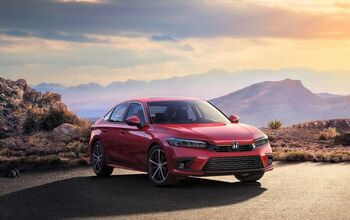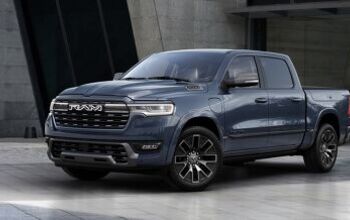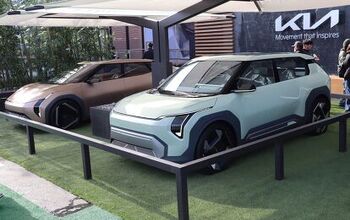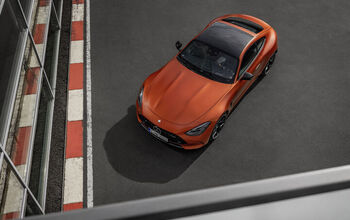2020 Honda Civic Type R Vs 2020 Mercedes-AMG A 35 Comparison

Despite the bustling SUV crowd, it’s heartening to see a brand like Mercedes-AMG willing to dip its toes in the hot hatch pond.
So it was only natural that some hot-hatch fanatics came along and pit the 2020 Mercedes-AMG A 35 against the crowd-favorite (arguably) Honda Civic Type R.
Pleasantries aside, the white and the red are two very different cars. Where the Type R adamantly sticks to its front-wheel-drive roots, the AMG A 35 takes a more contemporary (read, German) AWD approach. And that is just one of many distinctions that, despite their similar body styles, make them as different as night and day.
Row, Row, Row Your Boat… Or Don’t
Civic Type R: The transmission is possibly the main differentiating factor between the two entrants here. Not enough can be said about the close-ratio six-speed manual that has been an integral part of the CTR package since the EP3–the first CTR used a five-speed–and it is a treat to use. Even Kyle, our resident Porsche expert and editor couldn’t stop gushing about how great the shifter felt. The shift throws are short and precise. All you need to do is guide the stick to the next gear, and it shifts immaculately.
Some might complain that the auto rev match is a crutch, is impossible to turn off on the fly, and you should heel and toe, or in my case toe and toe, to rev-match yourself. I admire the sentiment, but the auto-rev match makes the car much friendlier than it would otherwise be.
You don’t need to think twice before shifting from third to second doing 40 mph, which could be intimidating for someone new to the high output-manual format. Driving stick is a skill, especially in today’s world, and if you want people to continue to love manuals, make them novice-friendly. Kudos to Honda for that.
If you do switch off the rev-matching, things get snappy, fast. The CTR and you passenger will smack you on the head if you don’t heel and toe properly. So from an engagement perspective, the CTR is way ahead of the car it goes up against. Also, might I add, when you do get the confidence to rid your driving of the auto rev-match, you would have improved your skill as a driver. Learning is fun!
SEE ALSO: 2020 Honda Civic Type R Review: An Open LetterAs for the engine, it makes 306 hp from two liters of turbocharged fury. It isn’t too far off the Merc’s output, plus, they both make the same 295 lb-ft of peak torque. We had pointed out in our solo CTR review that the engine sounds meh at best. And that is after you get the synthesized sound from the speakers which is a bit off-putting. Plus, it’s not a “real” VTEC, as Honda has moved the variable lift from the intake to the exhaust since the K20C1 is turbocharged. There’s no doubt that it works and you do get an extra jolt around 6,000 rpm.
AMG A 35: I am with Kyle when he says “It takes is a few hundred feet to know that Merc wouldn’t have been able to match the feel of the CTR’s shifter. It’s better it didn’t even try.” Mercedes hasn’t offered a manual car in North America for years, though it has perfected its DCT transmission in the meantime. And we both agree that the seven-speed DCT suits the overall sophistication of the AMG better than a manual. Yes, you miss the engagement the six-speed manual brings to the table, but the pop-and-bang overruns make up for the absence of the stick.
SEE ALSO: 2020 Mercedes-AMG GLC 43 Review: Aufrecht Melcher GoldilocksAs far as user-friendliness goes, it doesn’t get simpler than flappy-paddles. The shifts are quick and you feel the difference in pace almost instantaneously. And I would go as far as to say that for straight-line progress, the paddle-shifters perform better than the manual and rev-match is a default setting.
If a great sounding exhaust note is among your top priorities you will love the 35. I wouldn’t have held it against Honda if it had aped the Merc’s exhaust note. Kyle explains: “I didn’t expect the better soundtrack to come from the three-pointed-star car, either. Anybody who’s heard an AMG V8 knows the company produces great singers, but a production-line inline-four? It works. It’s rorty, all low-down base with some parp-parp flatulence on the downshift.” The power delivery is near identical to the Honda, with that quintessential turbo mid-range strength and a punch of top-end power. An identical redline of 7,000 rpm makes the engines more similar than either of us expected. But the main differentiating factor, as we mentioned before is the transmission.
Bottom Line: While the A 35 certainly sounds better, especially during downshifts, and the parp-parp is music to the ears, the Civic Type R just feels purer. The manual gearbox keeps you engaged, involved and makes you feel in charge of how the car behaves—something auto gearboxes cannot match. Yes, it comes with responsibility but isn’t that the point?
Bumps and Corners
Civic Type R: The Civic feels like at least two cars rolled into one, if not three. It comes with three driving modes—Comfort, Sport, and +R mode—and just to make its priorities abundantly clear, the default mode is Sport. Want it in Comfort when you start? Use the button bro. Having said that, the drive mode selector completely changes the Type R’s character depending on which side you flick the switch. In Sport it is the perfect back-road corner carver, the throttle is at its most responsive and so is the steering. It really is the sharpest tool in the front-wheel-drive shed and makes the case for AWD pretty redundant without the weather being a factor.
SEE ALSO: 2020 Honda CR-V Review: A Cross For The Weekend?The slightest twitch from the steering and the nose is already in line with the corner entry. Brakes and throttle engage if you cough on them and the feel from it all is simply unmatched from any front-wheel-drive car on the market. It feels darty and full of excitement all the time. If you want to be even more hardcore, the +R mode stiffens up the already stiff adaptive dampers even further. In this mode, the Type R really comes together, and it is quite apparent why it is considered the best modern front-drive car in the world. Helical LSD aside, the suspension keeps the car stuck to the road, the ride gets stiff, very stiff but you never run out of grip, ever. In fact, if you push too hard into a corner, you feel a slight oversteer instead of the typical FWD understeer.
Then when you’re done scaring your passengers, and the rear is splattered with toddler hurl, you can switch to Comfort mode and the Type R becomes an almost-Civic. The suspension, steering, and throttle become much more deliberate. But the brakes retain their sharpness regardless of driving mode.
It still feels stiffer than a regular Civic but is quite manageable. You feel the beast underneath; Comfort mode is the muzzle. If you think I’m a little too gaga over the CTR, you’re right—so here’s a second opinion, “The CTR’s biggest strength is how it blends in on the daily grind. I’m talking about the ride—it always looks like a flying origami monster. Stick it in [Comfort] and the CTR is downright comfortable, soaking up bumps and cruising the highway with minimal noise. Even the 20-inch wheels can’t ruin it.” Unlike others; looking at you Mercedes.
AMG A 35: I expected a bit more from the three-pointed star if I’m being honest. It is the reigning Formula 1 champion after all. But all that transfers to the A 35 is the absurdly stiff suspension. Okay, I exaggerate, but trust me, not by much. You will feel every single blemish on the road. It’s great if you are on the back roads making hasty progress and want to feel the road on your hindquarters. But in traffic on pockmarked city roads, it gets tiring rather quickly. This isn’t even the “real” AMG of the A lineup, either: there’s the manic A 45 at the top of the pile, and we both wonder what it must be like.
The ‘why’ only becomes apparent when the speeds climb and you really start pushing the car. We both agree that the Type R is a sharper drive. The A 35 is by no means a slouch, but it requires the conditions to suit its set up. “The A 35 needs a bit of speed behind it to really settle into its ride, preferring smoother tarmac,” says Kyle, “when it’s there, it feels great, the damping relaxing a bit and letting the car breathe with the surface a little more.”
I couldn’t agree more.
Though you do get different driving modes on the A 35, they only seem to change the throttle and gear change severity. You are simply stuck with the racecar-like suspension setup. Even with the optional three-stage damping sport suspension, the A 35 simply goes from stiff to vertebrae-jarring. Also, even in its sportiest setting, the A 35 never feels as sharp as the CTR. It feels a hair heavier in the turns, likely because of the on-demand AWD. Though AWD will certainly play a role when the weather dampens, in the dry, it comes at the cost of agility.
SEE ALSO: 2019 Hyundai Veloster N: I’m Not a Regular Dad, I’m a Cool DadBottom Line: The Mercedes-AMG A 35 is a good all-round driver’s car. It’s got the setup and it certainly has the power to match. But the Honda Civic Type R outperforms the AMG-ish hatch in every way, except maybe wet weather handling which the A35 is better equipped to handle. So the Type R is the clear winner here. However, had Mercedes flipped the suspension with the throttle and steering setup, the winner would have been quite difficult to declare.
Cabin Behind The Hoods
Civic Type R: Though the Type R’s cabin is far from spartan, it’s not what you would call luxurious. Or for that matter, premium. Sporty could be an apt adjective but I would go with, RED. You can’t move around the cabin without touching something that’s not red. Seatbelts, seats, even the infotainment, background color, all red. Apart from that, the dash and center section is very Civic.
An Alcantara steering wheel feels really good in the hands and it’s perfectly round, awesome. There is enough space in the cabin for four adults but it becomes restrictive if you have a family of three. The superb seats are the culprit, unfortunately. Excellent cushioning and great comfort aside, the seats have vertical bolsters. They hold you in perfectly and are possibly one of the most comfortable seats I’ve been in, performance car or not. But they restrict movements to pacify the toddler in the back and getting in and out is awkward.
Space is not an issue, as even taller occupants will feel comfortable. You can’t squeeze three in the back though, because there is no middle seat—a point that will be hard-fought during buying decisions. Though the numbers label it as a spacious cabin, the restricted movements in the bolstered seats eat into the feeling of space.
AMG A 35: Well, it is a Mercedes. From the moment you step inside, you know you’re at the helm of something premium. The massive MBUX twin-screen all-digital instrument cluster/infotainment unit looks sharp and upmarket. The seats too, feel comfortable and are much less hardcore and outrageous than the ones on the CTR. There’s a liberal dose of Alcantara in here as well. The flat-bottom AMG steering is the same from the brand’s more expensive offerings, which is nice. Despite it being a part of something aimed to carve corners, the cabin feels oddly comforting. It’s a perfect example that you can have a dash of luxury in a (relatively) affordable hot hatch built to tackle corners.
If the numbers are anything to go by, the A35 offers more headroom than the Type R. And the rear bench comes with a middle seat. Seating three however will be a challenge, and the knee room is limited as well.
Bottom line: Neither car is built for rear passengers. Though the Civic is marginally more practical thanks to a larger trunk, the Merc offers three seats in the rear. It seems the Type R’s dash exists because it has to. The infotainment is mediocre at best and it just seems chaotic. It’s ergonomically sound just not very well designed. The A 35’s cabin on the other hand feels is more spacious. And the MBUX interface and clean dash design add sophistication to the cabin, which is missing from the Honda. While you work around the Honda’s dash/center dash setup, you work with the Merc’s and for that, it’s the clear winner here.
Looks Do Matter
Civic Type R: “It always looks like a flying origami monster.” exclaims Kyle. To me it looks like a Pokemon with the wrong evolution stone but you get the point. It isn’t a looker. In fact, it seems rather revolting at first but then you get to know it and you realize it has a sense of humor. After enough time behind the wheel you realize, the massive fake-ish vents, and the large rear wing are a part of its personality.
It might be cliched to say this in 2020, but it drives exactly as it looks and despite your best efforts you can’t fault it for that.
AMG A 35: The A 35 is arguably the most distinctive and best-looking hatchback out there, hands down. If you want to be seen driving a hot hatch, you’d want it to look like the Mercedes. The one we had was with the optional aero kit and it does make a car look like it came out of an amateur tuner salon, but you can choose not to opt for it.
If you do so you will save yourself the eyesore of watching the roof spoiler wobble when you shut the tailgate. Something that is unavoidable on the CTR too.
Bottom Line: Not much to say here. The Merc takes this one, by a mile.
Rocket and the Pocket
For disclosure’s sake, the A 35 hatch is only available in Canada. So the comparison will be in CAD. The AMG A 35 is available in the US as a sedan and is priced from $45,945 (including destination) before options while the Type R starts from $38,440 before options.
Civic Type R: There is no doubt that the Type R is a Civic at the end of the day with an asking price of $48,001 before options. For that, you get a car that looks (inside and out) fresh out of a tuner shop. But for the nearly $50,000 CAD price tag, you also get adjustable suspension, 20-inch wheels, 306 hp, Brembo brakes, and a world-renowned close-ratio six-speed manual. All as standard.
AMG A 35: Mercedes has placed the AMG A 35 quite close to the CTR. For the money, you get a smashing looking hot hatch with 302 hp and an impeccable seven-speed DCT. You also get a luxurious interior, a panoramic sunroof, leather seats, and possibly the best-in-class MBUX system.
But if you want adaptive suspension along with a data logger, AMG Drive Unit, and 19-inch sport alloys, that will be $2,500 extra. The Intelligent Drive Package, which includes active steering and brake assist with cross-traffic, auto emergency braking, blind-spot assist, and lane-keeping assist among others is $1,500 extra. A 360-degree camera is $650 more while the HUD will set you back by another $1,500. Finally, if you want keyless entry, Apple CarPlay, Android Auto, navigation, and road sign assist, you will need the Premium and Navigation Packages costing $3,200 and $1,000 respectively. Though the premium package also throws in the Burmester sound system.
Verdict: Honda Civic Type R vs Mercedes-AMG A 35 Comparison
Where the Honda Civic Type R is about pure performance—as it always has been—the Mercedes attempts to add a dash of upmarket luxury to its package apart from just performance. Both brands have a clear understanding of their target market. Anyone considering the CTR will be looking at a regular economy car upgraded to a performance machine while someone eyeing the Merc will mostly be looking at the three-pointed badge and the recognition that comes with it. Plus, customers have a plethora of options to customize the Merc according to their preferences.
But, as a car, as daily driver, the Mercedes fails to perform. Despite it looking like a Pokemon, the CTR is a much friendlier drive. Plus, things like blind-spot monitoring and front collision avoidance are optional on the Merc yet standard on the Honda. And for those reasons, despite the absurdly red interiors and an aging infotainment, it is a better everyday car whilst being fully capable of tearing up the track for a sub-$40,000 ($50,000 CAD) price tag.
Discuss this story at our Honda Civic Forum.
Become an AutoGuide insider. Get the latest from the automotive world first by subscribing to our newsletter here.

More by Kshitij Sharma















































Comments
Join the conversation